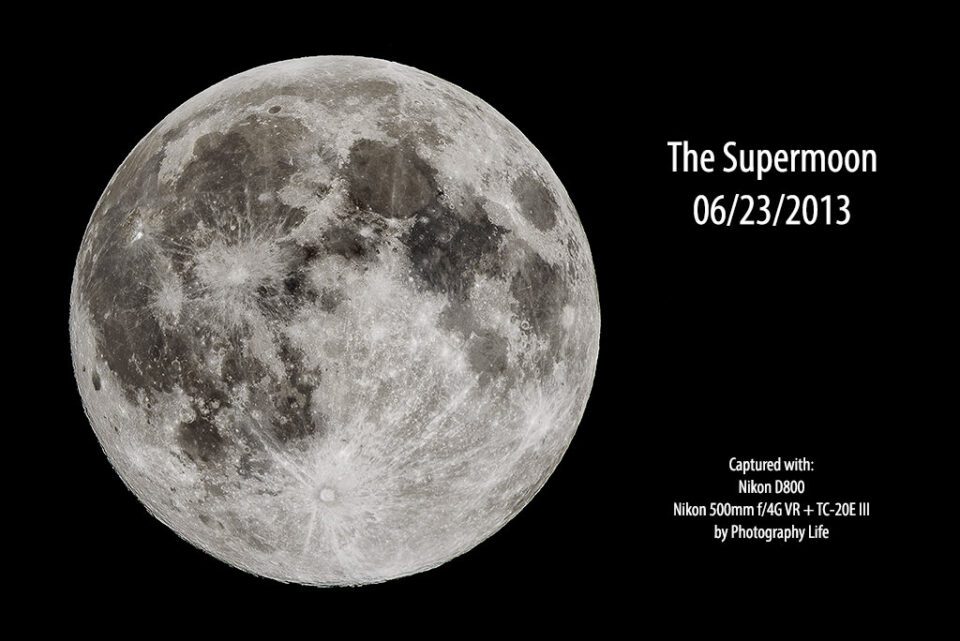If you have not heard yet, tonight, we will experience something truly magical – the supermoon of a lifetime! That’s right, the moon will be unusually close to our planet at 356,500 km, so close that we will not see another approach like that all the way until 2034! The size of the moon will be 14% larger than typical full moon. The so called “perigee moon” will coincide will the full moon, making it appear not only unusually large, but also unusually bright (up to 30% brighter than usual). Make sure to be prepared to capture this event, since it is such a unique, potentially once-in-a-lifetime moment! In this article, we have gathered all the important bits of information you will need to capture the supermoon, so read on and let us know if you are planning to do it.
First of all, let’s go over some of the articles that we have already posted on this site to capture the moon:
- How to photograph the moon – you will need to read this basic guide to understand the requirements and the exact techniques to capture the moon.
- How to photograph the supermoon – after you read the above, check out this specific article on photographing the supermoon. A few extra tips and techniques were added into the second article.
Keep in mind that photographing a full moon is nothing like photographing a lunar eclipse. You will not have to worry about increasing your camera’s ISO, since the moon is going to be very bright. This means that if you read the above two articles, you should be able to capture a crisp image of the moon without any noise in it.
Last time we had the supermoon on 06/23/2013, I went out and captured the above photograph of the moon in its full glory. Using a super telephoto lens with a focal length of 500mm, I was able to stack a 2x teleconverter to it to make it a 1000mm setup on a full-frame camera. Obviously, such a setup is very expensive – I actually had to borrow my friend Tom Redd’s 500mm lens to capture this shot. However, you don’t need a $ 10K lens to capture the amazing details of the moon tonight! With moon being so close, you could use a handy super telephoto zoom lens such as the 70-300mm, or if you have a 300mm f/4 lens, you can stack a 2x teleconverter to get you a shot of the moon at 600mm. Couple the setup with a high-resolution DX camera such as the Nikon D7200 or the D500 and you will be able to capture the moon with a lot of details. Those who are into astrophotography will probably be shooting with a dedicated telescope and a solid camera mount, although if the setup is too long, it would be pretty tough to keep track of the moon. Keep in mind that the closer you get to the moon in terms of framing, the harder it will be to readjust your setup – the moon moves crazy fast! In fact, you should check out the below video, where I captured the moon moving across the frame:
And that’s with a 300mm lens + a 1.4x teleconverter! I once tried to do the same thing with an 800mm lens and boy, I had a hard time readjusting my ballhead to keep everything stable. And that brings us to potential stability issues. If you shoot with a very long lens, you should totally read my advanced article on how to stabilize your tripod. Trust me, you will need every tool in your arsenal to make a blur-free image of the moon at focal lengths above 300mm, especially if you have a shaky tripod or unstable tripod head.
If you don’t have a super telephoto lens, should you skip the process of capturing the moon completely? Absolutely not! In fact, I would encourage you to still get out and photograph the moon. However, make it a challenge for yourself not just to photograph the moon by itself – try using your longest lens to photograph the moon together with a foreground subject. That’s going to be a real challenge and if you succeed, trust me, your photo will look much nicer than the moon against the dark sky.
And if you have previously photographed the moon by itself with a long lens, why not make this event more challenging by thinking about a nice foreground subject? Perhaps you could drive around your downtown area to compose the moon against the tall buildings. Perhaps you could head out to the mountains tonight to photograph the moon with beautiful mountain peaks. Just make sure to plan ahead of time. My PhotoPills app is telling me that the moon will be closest at 4:24 AM and it will set at 6:33 AM. If I wanted to capture the moon with a nice background, I would have to plan closer to moonset time.
Are you planning to get out tonight and photograph the moon? Let us know in the comments section below!
P.S. Don’t forget to share some pics of the moon after you capture it – we have a forum for that.
The post Photographing the Supermoon appeared first on Photography Life.







